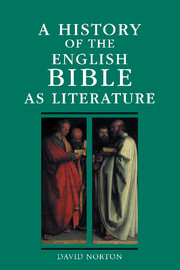Book contents
- Frontmatter
- Contents
- List of plates
- Preface
- List of abbreviations
- 1 Creators of English
- 2 From the Great Bible to the Rheims-Douai Bible: arguments about language
- 3 The King James Bible
- 4 Literary implications of Bible presentation
- 5 The struggle for acceptance
- 6 The Psalter in verse and poetry
- 7 ‘The eloquentest books in the world’
- 8 Writers and the Bible 1: Milton and Bunyan
- 9 The early eighteenth century and the King James Bible
- 10 Mid-century
- 11 The critical rise of the King James Bible
- 12 Writers and the Bible 2: the Romantics
- 13 Literary discussion to mid-Victorian times
- 14 The Revised Version
- 15 ‘The Bible as literature’
- 16 The later reputation of the King James Bible
- 17 The New English Bible
- Bibliography
- General Index
- Biblical Index
13 - Literary discussion to mid-Victorian times
Published online by Cambridge University Press: 05 June 2012
- Frontmatter
- Contents
- List of plates
- Preface
- List of abbreviations
- 1 Creators of English
- 2 From the Great Bible to the Rheims-Douai Bible: arguments about language
- 3 The King James Bible
- 4 Literary implications of Bible presentation
- 5 The struggle for acceptance
- 6 The Psalter in verse and poetry
- 7 ‘The eloquentest books in the world’
- 8 Writers and the Bible 1: Milton and Bunyan
- 9 The early eighteenth century and the King James Bible
- 10 Mid-century
- 11 The critical rise of the King James Bible
- 12 Writers and the Bible 2: the Romantics
- 13 Literary discussion to mid-Victorian times
- 14 The Revised Version
- 15 ‘The Bible as literature’
- 16 The later reputation of the King James Bible
- 17 The New English Bible
- Bibliography
- General Index
- Biblical Index
Summary
THE PIOUS CHORUS
If to adore an image be idolatry, To deify a book is bibliolatry.
This bon mot, the OED's first example of ‘bibliolatry’, comes from John Byrom (d. 1763) in the course of an argument against the idea that the Holy Spirit is present in the Bible, for ‘Books are but books; th'illuminating part / Depends on God's good spirit, in the heart’. Nearly a century later the English opiumeater, Thomas De Quincey (1785–1859) defined ‘bibliolatry’ as ‘a superstitious allegiance – an idolatrous homage – to the words, to the syllables and to the very punctuation of the Bible’. The invention of the word, though overdue, was particularly appropriate for the latter part of the eighteenth century and the nineteenth century, but what is most striking about De Quincey's engaging and witty discussion of bibliolatry is that none of it concerns literary attitudes. A new word is needed to denote not just literary bibliolatry but its English form, already so thoroughly evident, reverence for the KJB. ‘AVolatry’ (in preference to ‘KJBolatry’) has been rife since the 1760s. Typically it emerges in a pious chorus of adoration that is more often an exercise in rhetoric than criticism. Commentators seem to vie to produce the most resounding and memorable praise of the KJB.
The greatest spur to the chorus was the pressure of rival versions, and the chorus increasingly takes on a polemic aspect as argument for an official revision made it more and more possible that the revered old treasure would be left to moulder in the vault of antiquities. Yet it would be wrong to view the chorus as mere political agitation spurred by reactionary nostalgia.
- Type
- Chapter
- Information
- A History of the English Bible as Literature , pp. 299 - 326Publisher: Cambridge University PressPrint publication year: 2000



